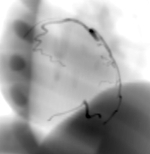CAVAREV
CArdiac VAsculature Reconstruction EValuation
Downloads
- Projection matrices
- Projection images (cardiac motion only)
- Projection images (cardiac and respiratory motion)
- Filtered projection images (cardiac motion only)
- Filtered projection images (cardiac and respiratory motion)
- Relative positions within a heart cycle (cardiac phase)
- Relative positions within a breathing cycle (respiratory phase)
- Example implementation: ECG-gated FDK (C++ version)
- Example implementation: ECG-gated FDK (MATLAB version)
Hall of Fame
| Method | Description | Q3D (card) | Q3D (card+resp) | Q4D (card) | Q4D (card+resp) |
|---|---|---|---|---|---|
| Spatio-temporally Regularized ECG-Gated Reconstruction [1] | Iterative reconstruction minimizing spatial and temporal total variation using narrowest gating windows possible | 0.87618 | 0 | 0 | 0 |
| Motion Compensation for ECG-Gated Reconstruction with Large Window Sizes [2] | ECG-Gated reconstruction & 2-D--2-D registration-based motion compensation | 0.822566 | 0.385929 | 0.319175 | 0.105012 |
| Residual Motion Compensation for ECG-Gated Reconstruction [3] | ECG-Gated reconstruction & 2-D--2-D registration-based motion compensation | 0.776345 | 0 | 0.279786 | 0 |
| Streak-Reduced ECG-Gated FDK Reconstruction [4] | ECG-Gated FDK reconstruction using an additional weighting function for reducing streaks artefacts | 0.743538 | 0.2084 | 0.617927 | 0.107976 |
| Dynamic Level Set Reconstruction [5] | Symbolic 4D Reconstruction Using Variational Dynamic Level Sets | 0.691807 | 0 | 0.605452 | 0 |
| ECG-Gated FDK Reconstruction | ECG-Gated FDK reconstruction using a cosine-square based weighting function | 0.594723 | 0.156411 | 0.500699 | 0.0965542 |
| Standard FDK Reconstruction | Non-gated FDK-Reconstruction without Gating, i.e. all projection data is used without any correction | 0.431399 | 0.206042 | 0.347023 | 0.105329 |
[1] O Taubmann et al. 2017: Spatio-temporally Regularized 4-D Cardiovascular C-arm CT Reconstruction Using a Proximal Algorithm. IEEE International Symposium on Biomedical Imaging (ISBI), Melbourne, Australia, pp. 52-55
[2] C Schwemmer et al. 2013: Opening Windows ‒ Increasing Window Size in Motion-Compensated ECG-gated Cardiac Vasculature Reconstruction. Proc. 12th intl. meeting on Fully Three-Dimensional Image Reconstruction in Radiology and Nuclear Medicine, Lake Tahoe, CA, USA, pp. 50-53
[3] C Schwemmer et al. 2013: Residual Motion Compensation in ECG-Gated Interventional Cardiac Vasculature Reconstruction. Phys. Med. Biol. 58(11), pp. 3717-3737
[4] C Rohkohl et al. 2008: C-Arm CT: Reconstruction of Dynamic High Contrast Objects Applied to the Coronary Sinus. IEEE NSS-MIC (Nuclear Science Symposium-Medical Imaging Conference), Dresden, Germany, pp. M10-328
[5] A Keil et al. 2009: Dynamic Cone-Beam Reconstruction Using a Variational Level Set Formulation. Fully3D, Beijing, China
Some results for iterative methods which were not made public on the web platform have been published in:
H Wu et al. 2011: Total Variation Regularization Method for 3-D Rotational Coronary Angiography. BVM (Bildverarbeitung für die Medizin), Lübeck, Germany, pp. 434-438


 +49-9131-85-27775
+49-9131-85-27775
 +49-9131-85-27270
+49-9131-85-27270

